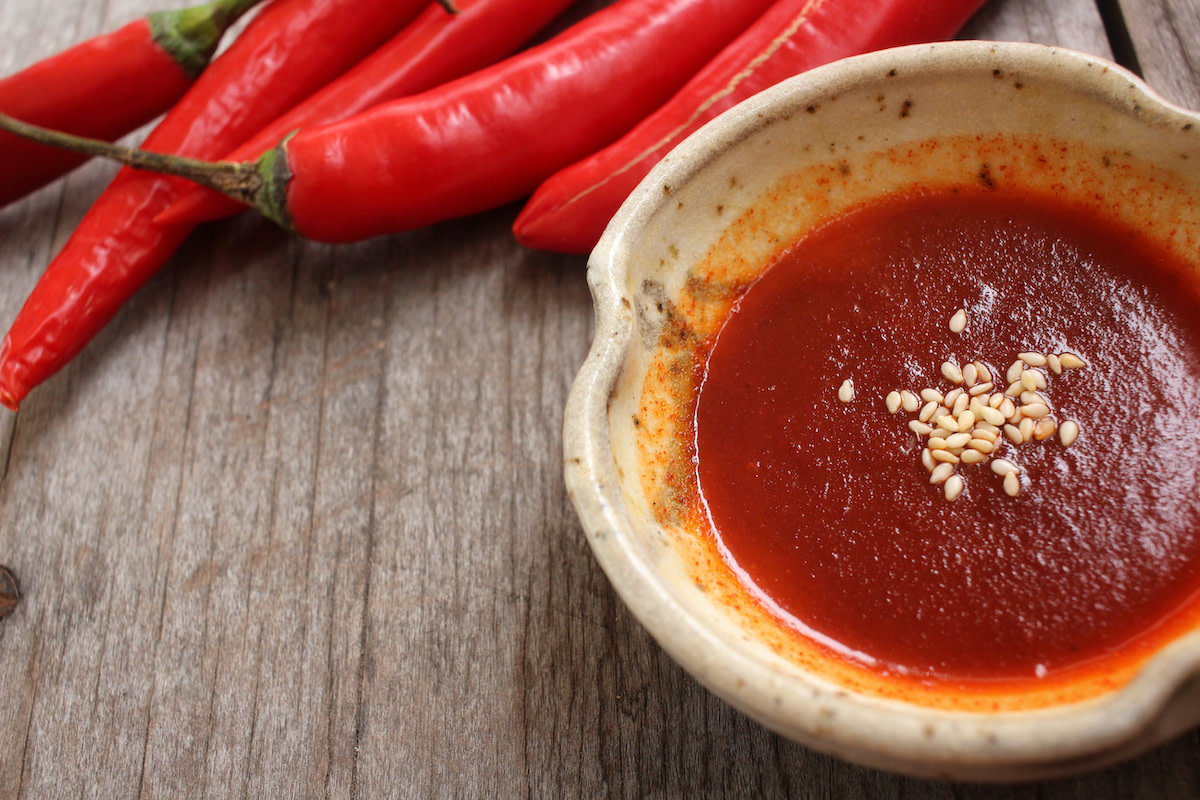Gochugaru vs. Gochujang: How the Korean Chili Spices Differ
Written by MasterClass
Last updated: Oct 22, 2021 • 4 min read
Gochugaru is ground Korean chili pepper, while gochujang is a chili paste. Both are staples of Korean cooking and even derive from the same pepper; however, they are distinct ingredients.
Learn From the Best
What Is Gochugaru?
Korean gochugaru is a Korean chili powder or chili flake, depending on how you make it or the brand you acquire. Korean cuisine uses these red pepper flakes in all sorts of dishes, including cold salads, kimchi, stews, and more. Gochugaru has a vibrant red color and a smoky flavor that is also a little fruity. The heat level varies—there are mild options and spicy options, depending on how many of the pepper seeds end up in the final product.
Korean red chili peppers called taeyangcho, sometimes called gochu peppers, are the primary hot pepper in gochugaru. Blend or grind the dried chili until the consistency is that of flakes or powder. Cooks use gochugaru to make gochujang, a spicy Korean chili paste with the same distinct red color and spicy flavor. You can find gochugaru in grocery stores, specialty food stores, or Asian markets. Import it from Korea, or look for the ingredient labeled Korean chili flakes, Korean pepper powder, or Korean chili powder in other grocery stores.
What Is Gochujang?
Gochujang is a bright red chili paste similar to gochugaru, the Korean chili powder—both come from the taeyangcho pepper but undergo entirely different production processes. Gochujang is a thick, fermented condiment that’s spicy, sweet, and often appears in Korean cooking. Gochugaru is actually a main ingredient in gochujang, along with glutinous rice, fermented soybean powder (fermented soybeans in powder form), barley malt powder, and salt. The fermented soy beans give the gochujang sauce a tangy, umami flavor, and the gochugaru gives it the spiciness.
Gochujang mixed with doenjang is the base for ssamjang, a popular dipping sauce in Korean barbecue, and in marinades for Korean barbecue meats like bulgogi and bibimbap. Gochujang rates on the Scoville Heat Units (SHU) scale at less than 1,000 units, while gochujang is on the even milder side. For comparison, a jalapeño pepper’s rating comes in at 2,500–8,000 units.
Gochugaru vs. Gochujang: How the Spices Compare
While gochugaru powder is a main ingredient in gochujang paste, and they can both be either maewoon (spicy) or deolmaewoon (less spicy), these ingredients fulfill different purposes in Korean cooking. Here are three key areas of difference between gochugaru and gochujang:
- Fermentation: Gochujang undergoes fermentation, while gochugaru does not. Gochujang includes fermented soybean powder and undergoes a fermentation process in which enzymes culture the glutinous rice flour, breaking down sugars. It takes about three months to ferment gochujang properly. On the other hand, gochugaru is just purely crushed gochu peppers—there is no fermenting or additional ingredients.
- Flavor: The flavor profiles of gochugaru and gochujang are entirely different; therefore, you can’t use them interchangeably. Both lend a distinct flavor to Korean dishes, but gochujang has a much more complex flavor than gochugaru due to the fermenting process it undergoes. Gochugaru simply provides a bit of heat and smokiness, while gochujang provides a sweet, tangy, and spicy flavor.
- Texture: Gochugaru is a chili pepper flake, while gochujang is a thick chili pepper paste, so they behave differently in recipes. Gochugaru is more similar to red pepper flakes, which appear frequently in Italian cuisine. Gochujang, while still being a hot pepper paste, is not as spicy as other hot sauces, such as sriracha.
3 Ways to Use Gochujang and Gochugaru
Korean recipes commonly call for both gochugaru and gochujang—sometimes at the same time and sometimes entirely on their own. Below are three ways you can consider using gochugaru, gochujang, or both:
- 1. In marinades: Use both gochujang and gochugaru in marinades for meat, fish, and even veggies. Add moisture to a gochugaru marinade, like sesame oil or soy sauce, to hydrate the pepper flakes to distribute them evenly. For the gochujang paste, thin it out with water or sesame oil or rub it directly onto whatever food you are marinating.
- 2. In sauces: Gochujang is an essential ingredient in ssamjang, a sauce that accompanies many Korean foods, especially Korean barbecue. But you can use both Korean spice elements—gochujang and gochugaru—in a sauce for tteokbokki (spicy Korean rice cakes) or in a sauce for coating noodles and veggies.
- 3. In seasoning blends: For Asian spice blends, you can use gochugaru much like you would use cayenne pepper, Aleppo pepper, or chipotle powder in Mexican dishes—to add heat and possibly even a touch of smokiness. You can consider using gochugaru or gochujang paste as a seasoning for sticky rice or brown rice. Additionally, you can use a combination of the seasonings in classic Korean stews like jjigae.
Want to Learn More About Cooking?
Become a better chef with the MasterClass Annual Membership. Gain access to exclusive video lessons taught by the world’s best, including Niki Nakayama, Gabriela Cámara, Chef Thomas Keller, Yotam Ottolenghi, Dominique Ansel, Gordon Ramsay, Alice Waters, and more.
